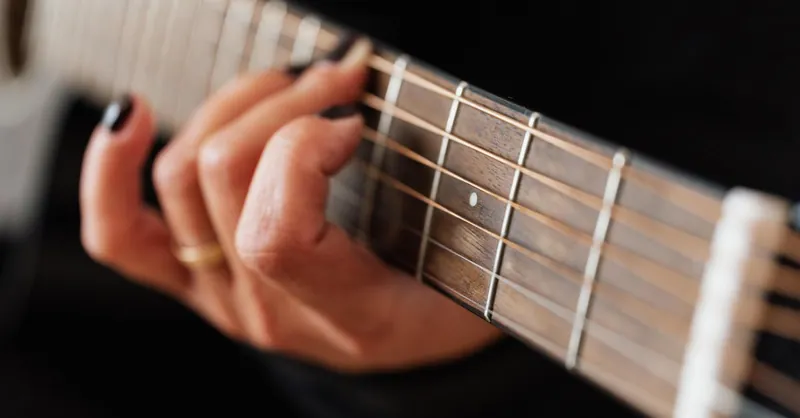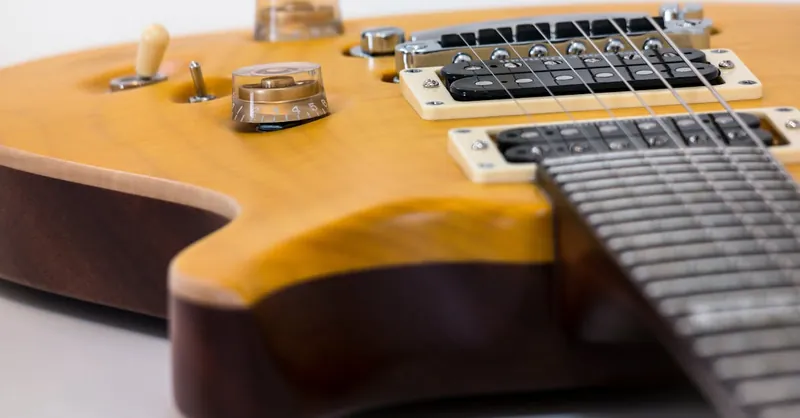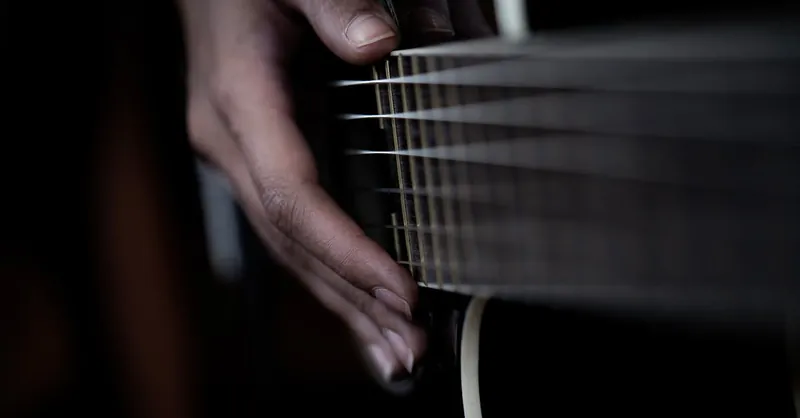Master Blues Guitar Scales and Licks for Ultimate Expression
Category: Guitar Gear
Unlock the Secrets of Blues Guitar Scales and Licks
If you've landed here, you're likely a guitar player craving to elevate your blues playing to a new level. Perhaps you've struggled to find the right scales that truly capture that soulful blues feel or have felt stuck when it comes to crafting memorable blues licks that resonate with listeners. Whether you're a beginner trying to grasp the basics or an intermediate player looking to refine your technique and vocabulary, this post is tailored just for you. Blues guitar is about emotion and storytelling, and mastering its scales and licks is essential to convey that depth. Unlike generic tutorials, this guide breaks down the scales and licks systematically while blending practical tips, classic examples, and playing techniques that bridge theory with real-world application. As a blog focused on guitar playing, gear, effects, and music production, we’ll not only teach you the scales and licks but also how to integrate them with the right gear and tonal settings. Stick around to unlock the blueprint that guitar greats have honed and find your unique voice in the blues.
- Unlock the Secrets of Blues Guitar Scales and Licks
- Understanding the Blues Scale: Structure, Notes, and Variations
- Essential Blues Scales Beyond the Basics
- Crafting Classic Blues Licks Using Scales
- Techniques to Bring Your Blues Licks to Life
- Connecting Licks and Scales Over the Blues Progression
- Gear and Effects to Shape Your Blues Tone
- Improvisation Tips for Using Blues Scales and Licks Creatively
- Analyzing Blues Guitar Legends: Scale and Lick Inspirations
- Practice Routines and Exercises for Mastery
- Integrating Blues Scales and Licks into Your Own Playing Style
Understanding the Blues Scale: Structure, Notes, and Variations
At the heart of every great blues solo lies the blues scale, a foundational tool that shapes the genre’s distinctive sound. The most common starting point is the minor pentatonic scale, a five-note scale consisting of the root, minor third, fourth, fifth, and minor seventh intervals. What gives the blues scale its unique flavor is the addition of the infamous "blue notes" — specifically the flattened fifth (also called the diminished or blue fifth) and occasionally the blue third. These notes introduce tension and expressiveness that evoke the raw emotional quality synonymous with blues music.
The Minor Pentatonic Scale: Your Blues Backbone
The minor pentatonic scale can be visualized as follows (using A minor pentatonic for example):
- A (root)
- C (minor third)
- D (fourth)
- E (fifth)
- G (minor seventh)
When you add the blue note—the flattened fifth (Eb in the key of A)—you create the classic blues scale. This single note bridges the gap between the fourth and fifth, allowing for expressive slides, bends, and vibrato that define blues lead playing.
Blues Scale Variations: Expanding Your Blues Vocabulary
While the minor blues scale is the most widely used, it’s worth exploring the major blues scale as well, which brings a brighter, more optimistic tone by incorporating the major third and a flattened third (sometimes called the blue third). This variation is particularly useful over major blues progressions and allows for a different emotional palette.
Here’s a quick comparison:
| Scale Type | Notes (Key of A) | Characteristic Notes | Best Used For |
|---|---|---|---|
| Minor Pentatonic | A - C - D - E - G | Minor third (C), minor seventh (G) | Classic blues, rock, and soul |
| Minor Blues Scale | A - C - D - Eb - E - G | Flattened fifth (Eb), blue note | Traditional blues leads |
| Major Blues Scale | A - B - C - C# - E - F# | Major third (C#), blue third (C) | Major blues progressions, upbeat licks |
Understanding these scales and how their notes interact with the underlying chord changes is essential for crafting expressive licks and solos. Mastery of the blues scale forms the backbone of blues guitar playing, providing the raw material from which countless legendary riffs and solos have been born. Master these scales, and you’ll unlock the language of the blues.

Image courtesy of Nathan Martins
Essential Blues Scales Beyond the Basics
Once you’ve internalized the classic minor and major blues scales, it’s time to expand your expressive toolkit with some essential blues scales beyond the basics. These scales offer fresh tonal colors and new melodic possibilities that can elevate your solos from formulaic to truly captivating.
Mixolydian Mode: Adding a Funky, Bluesy Flavor
The Mixolydian mode is a major scale with a flattened seventh, and it’s incredibly important in blues and blues-rock contexts. Unlike the minor pentatonic’s raw tension, Mixolydian brings a laid-back, dominant-chord vibe that fits perfectly over typical blues progressions (like the I7-IV7-V7). For example, in the key of A Mixolydian:
- A (root)
- B (major second)
- C# (major third)
- D (perfect fourth)
- E (perfect fifth)
- F# (major sixth)
- G (minor seventh)
This scale expands the palette by incorporating the major third and the dominant seventh, allowing for pronouncing chord tones in your solos and blending beautifully with rhythm sections.
Dorian Mode: A Minor Scale With a Twist
The Dorian mode is a minor scale variant that features a natural sixth instead of the typical minor sixth. This small tweak adds a jazzy, soulful touch to blues solos and works great over minor blues progressions. For A Dorian:
- A (root)
- B (major second)
- C (minor third)
- D (perfect fourth)
- E (perfect fifth)
- F# (major sixth)
- G (minor seventh)
Using Dorian helps you break out of the fixed blues scale box by introducing more melodic options, especially for crafting licks with a modal or jazz-inflected feel.
Diminished/Blues Hybrid Scales: Injecting Edge and Complexity
For players eager to add tenseness and sophistication, hybrid scales mixing diminished scale fragments with blues elements open up exciting possibilities. The diminished scale (whole-half or half-whole) is built from alternating whole and half steps, creating a symmetrical, dissonant sound. When blended subtly with blues scale notes, it allows for dramatic chromatic runs, unexpected tension, and release moments.
For instance, incorporating a diminished passing tone between the blues scale’s flat fifth and fifth can create a compelling tension that resolves beautifully back into the core blues sound. Experiment with these hybrid scales to craft solos that stand out with both traditional blues grit and modern complexity.
By integrating the Mixolydian mode, Dorian mode, and diminished/blues hybrid scales into your soloing vocabulary, you’ll vastly expand your expressive range and tonal color. Each scale offers a unique emotional shade—from funky and dominant to soulful and unexpected—providing essential tools for crafting memorable, dynamic blues guitar solos. Mastering these scales not only deepens your understanding of blues theory but also empowers you to innovate and personalize your playing with confidence.

Image courtesy of Pixabay
Crafting Classic Blues Licks Using Scales
Understanding blues scales is essential, but crafting iconic blues licks is where theory meets expressive, soulful playing. Classic blues licks are built by selecting and sequencing notes from the blues scale, often emphasizing certain chord tones and blue notes to create emotional impact. These licks rely heavily on masterful phrasing, rhythmic variation, and tasteful use of embellishments such as bends, slides, and vibrato.
The Anatomy of a Classic Blues Lick
A typical blues lick often follows these structural elements:
- Start with a strong root or minor third – establishes the tonal center.
- Incorporate blue notes (flattened fifth or blue third) – adds tension that resolves either up or down.
- Use rhythmic syncopation – creates groove and swing feel.
- Finish on a chord tone (usually the fifth or minor seventh) – provides resolution.
For example, a quintessential blues lick in A minor might sequence the notes: A (root) → C (minor third) → Eb (blue note) → E (fifth), using a bend from Eb up to E to emphasize tension and release. This structure allows you to tell a musical story within just a few notes.
Essential Embellishments to Bring Licks to Life
Blues guitar is as much about expressiveness as it is about note choice. Incorporate these key techniques into your licks:
- Bends: Slight or full bends on the blue note or minor third simulate vocal inflection and emotional pleading.
- Slides: Sliding into a note from a half or whole step below adds dynamic movement and fluidity.
- Vibrato: A controlled vibrato on sustained notes adds warmth and depth.
- Grace Notes: Quick hammer-ons and pull-offs enrich the lick’s texture.
- Double Stops: Playing two notes simultaneously (often the root and fifth) enhances harmonic interest.
Classic Blues Lick Example in TAB
Here’s a simple but effective blues lick in A minor, demonstrating these concepts:
e|-----------------------------5b7r5--------------------|
B|-----------------------5h6----------6~----------------|
G|---------------5/7-------------------------------------|
D|-------------------------------------------------------|
A|-------------------------------------------------------|
E|-------------------------------------------------------|
- 5b7r5: Bend from 5th fret note up a whole step and release
- 5h6: Hammer-on from 5th to 6th fret adding subtle flair
- 6~: Vibrato on the 6th fret note
- 5/7: Slide ascending from fret 5 to 7 on the G string
This lick encapsulates the call-and-response feel that is a hallmark of blues solos, blending tension and release through precise note choices and phrasing.
By breaking down iconic blues licks derived from the scales discussed earlier, focusing on lick structure, smart note selection, and expressive phrasing, you can begin to play solos that sound both authentic and captivating. Remember, emulating blues legends is invaluable, but adding your own voice through tasteful embellishments and personalized phrasing is what ultimately defines great blues guitar playing.

Image courtesy of Nathan Martins
Techniques to Bring Your Blues Licks to Life
Mastering blues guitar scales and licks is essential, but what truly gives your playing authenticity and emotional impact are the expressive techniques that breathe life into every note. Legendary blues guitarists like B.B. King, Stevie Ray Vaughan, and Eric Clapton harnessed an arsenal of techniques—string bending, hammer-ons, pull-offs, vibrato, slides, double stops, and dynamic control—to transform simple scale runs into soulful, vocal-like storytelling.
Key Techniques for Expressive Blues Playing
-
String Bending: Possibly the most iconic blues technique, bending allows you to raise the pitch of a note to a target tone, often one or two semitones higher. Bends highlight emotional tension by mimicking the human voice’s inflections, especially when bending the blue note or the minor third up to the major third. Experiment with both full bends (e.g., a whole step) and micro-bends (quarter or half steps) for subtle expression.
-
Hammer-Ons and Pull-Offs: These smooth, legato techniques enable you to add ornamental grace notes and quick note transitions without picking every note. Hammer-ons and pull-offs enrich blues licks by creating fluidity and rhythmic interest, making phrases sound more conversational and less mechanical.
-
Vibrato: Applying controlled vibrato—a subtle oscillation in pitch—on sustained notes adds warmth and depth to your playing. Slower, wider vibrato often conveys greater emotional weight, while faster, narrower vibrato can inject urgency. Combine vibrato with bent notes to maximize expressive effect.
-
Slides: Sliding into or between notes creates seamless transitions and a “gliding” feel that enhances the vocal quality of your playing. Use slides to approach important chord tones or to emphasize blue notes, often sliding from a half or whole step below.
-
Double Stops: Playing two notes simultaneously, commonly intervals like the root and fifth or the minor third and seventh, adds harmonic richness to your licks. Double stops can accentuate a phrase or provide punchy rhythmic hits, framing your lead lines with raw blues intensity.
-
Dynamics: Varying your attack strength and picking intensity adds layers of emotional nuance. Soft, gentle picking can express vulnerability, while aggressive attacks and palm muting deliver grit and power. Pay attention to volume swells and note length to sculpt your phrasing dynamically.
By incorporating these essential techniques into your blues vocabulary, your licks will transcend mere note sequences, becoming expressive narratives full of character and soul. Experiment with combining bends, slides, and vibrato within your phrases and listen closely to the nuances of blues greats—this will help you internalize the feel and develop your own unique blues voice. Applying these techniques strategically not only enhances your technical skill but also connects you deeply with the emotional heart of blues guitar playing.

Image courtesy of Photo By: Kaboompics.com
Connecting Licks and Scales Over the Blues Progression
To truly master blues guitar, it’s crucial to understand how to navigate the 12-bar blues progression using your arsenal of scales and licks. The key lies in strategically targeting chord tones and skillfully creating tension and release throughout your solo. By aligning your note choices with the underlying chord changes—typically the I7, IV7, and V7 chords—you make every lick feel intentional and musically connected, elevating your playing from random runs to compelling storytelling.
Targeting Chord Tones for Musical Phrasing
Each chord in the blues progression contains specific chord tones that define its character. When you focus your licks around these tones—such as the root, third, fifth, and seventh—you emphasize the harmony and create a stronger connection between your solo and the rhythm section. For example:
- Over the I7 chord (e.g., A7), targeting the notes A (root), C# (major third), E (fifth), and G (minor seventh) will highlight the dominant sound.
- When the progression moves to the IV7 chord (D7), incorporating D (root), F# (major third), A (fifth), and C (minor seventh) in your lines grounds your solo in the new harmonic context.
- Over the V7 chord (E7), emphasizing E (root), G# (major third), B (fifth), and D (minor seventh) creates resolution anticipation.
Shifting focus between scale tones and chord tones as the progression evolves allows your licks to “talk” with the harmony, making solos feel more dynamic and authentic.
Creating Tension and Release with Blue Notes and Approach Tones
A hallmark of blues lead playing is the masterful manipulation of tension and release. The blue notes—like the flattened fifth or minor third—act as tension makers that seek resolution into chord tones. For instance, bending the flattened fifth (Eb in A blues) up to the perfect fifth (E) is a classic tension-release move that hooks listeners emotionally.
Besides blue notes, using chromatic passing tones or approach tones right before chord tones injects surprise and musical interest. These approach notes briefly clash before resolving, adding a soulful edge and making your licks less predictable.
Practical Tips for Seamless Scale and Lick Integration
- Map chord tones within your scale shapes: Visualize where chord tones lie in your blues scale positions to easily target them during improvisation.
- Phrase licks to anticipate chord changes: Try ending a lick on a chord tone as the progression moves, then start the next phrase emphasizing new chord tones.
- Use bends and slides to connect blue notes to chord tones: This creates smooth tension-release and vocal-like expressiveness.
- Experiment with scale choice over chords: For example, use Mixolydian or Dorian modes to color licks differently on each chord while maintaining connection through shared chord tones.
By consciously connecting your blues licks and scales to the 12-bar blues progression through chord-tone targeting and expressive tension-release techniques, your solos become more cohesive, compelling, and full of emotional depth. This approach is what separates proficient players from great blues guitarists – it transforms note runs into meaningful musical conversations.

Image courtesy of Pixabay
Gear and Effects to Shape Your Blues Tone
Achieving an authentic, expressive blues tone goes far beyond mastering scales and licks—it hinges significantly on your gear choice and how you utilize amplification and effects. The right combination of guitar, amplifier settings, and effects pedals can profoundly influence your blues solo’s character, warmth, and emotional impact, helping you inject soul and depth into every note.
Guitar Choice: Finding Your Soulful Voice
The classic blues tone is often associated with guitars that provide rich midrange response, warm dynamics, and smooth playability. Popular choices include:
- Single-coil pickups (like those on Fender Stratocasters) deliver a bright, articulate sound perfect for crisp bends and subtle nuances.
- Humbuckers (found on guitars like Gibson Les Pauls) offer thicker, warmer tones with natural overdrive, ideal for blues-rock styles.
- Semi-hollow and hollow-body guitars add natural resonance and sustain, contributing to a vintage blues vibe perfect for dynamic expression.
Selecting a guitar with comfortable neck profiles and responsive pickups helps you execute bends, vibrato, and slides with greater ease and precision, enhancing your ability to communicate emotion through your blues scales and licks.
Amplifiers and Settings: Dialing in Your Tone
Your amp is arguably the most critical component for shaping your blues sound. Tube amplifiers are preferred for their organic warmth, dynamic touch sensitivity, and natural compression. Some amplifier tips include:
- Set the gain moderately to allow for natural breakup when you dig in with your picking hand, delivering that dynamic touch response central to blues phrasing.
- Boost mids and slightly roll off highs to emphasize the vocal-like quality of your licks, avoiding harshness that can detract from soulful expression.
- Utilize the amp's reverb subtly to add depth and space without washing out your articulation.
Famous amplifier models like the Fender Blues Junior, Vox AC30, and Marshall Bluesbreaker have shaped iconic blues tones by offering responsive, warm overdrive perfect for blues guitar soloing.
Essential Effects to Enhance Your Blues Playing
While classic blues tones are often straightforward, tasteful use of effects can elevate your sound—especially when matching your gear with blues scales and licks.
- Overdrive: A mild overdrive pedal adds harmonic richness and sustain, helping notes sing and bends sustain longer. It allows your blues licks to "bloom" smoothly over the rhythm section. Popular pedals include the Ibanez Tube Screamer and Fulltone OCD.
- Delay: Short, subtle delay effects can thicken your solos and add a sense of space. Use delay sparingly to avoid muddying fast runs, opting for slapback or analog-style delays that complement blues phrasing.
- Reverb: A spring or plate reverb tail provides natural ambiance and warmth, mimicking small club environments where blues thrives. Adjust reverb mix to keep your tone present yet immersive.
Recommended Setup for Blues Scales and Licks
To bring out the full character of your blues scales and licks, consider this setup blueprint:
| Gear Element | Recommended Settings/Type | Benefit for Blues Playing |
|---|---|---|
| Guitar | Fender Stratocaster or Gibson Les Paul (humbuckers) | Articulate bends, warm midrange response |
| Amplifier | Tube amp (e.g., Fender Blues Junior), moderate gain | Responsive dynamic touch, natural overdrive |
| Overdrive Pedal | Mild gain with mid boost (e.g., Ibanez Tube Screamer) | Enhances sustain and harmonic complexity |
| Delay | Short slapback delay, low mix | Adds spatial depth without clutter |
| Reverb | Spring or plate reverb, low to medium mix | Creates ambiance, enriches tone without washing out notes |
With the right gear and finely tuned effects, your blues guitar scales and licks will not only sound technically correct but resonate with soulful tone and vibrant expressiveness. Experimenting with the interplay of your guitar’s pickups, amp voicing, and subtle effects allows you to craft a signature blues voice that complements your musical ideas and emotional storytelling on the instrument.

Image courtesy of Kelly
Improvisation Tips for Using Blues Scales and Licks Creatively
Mastering blues scales and licks is only the first step; the true artistry comes from improvising with them creatively to craft dynamic, soulful solos that captivate your listeners. To elevate your blues improvisation, focus on motif development, call and response phrasing, and rhythmic variation—techniques that breathe life and uniqueness into your playing.
Develop Motifs to Build Cohesive Solos
Instead of playing endless scale runs, choose small melodic motifs—short, memorable phrases or rhythmic patterns—and develop them throughout your solo. Repeating a motif with subtle variations such as changing rhythm, altering one or two notes, or shifting the motif up or down the neck creates coherence and narrative within your improvisation. This approach not only grounds your solo thematically but also engages your audience by creating recognizable musical ideas.
Utilize Call and Response Phrasing
Emulate the classic blues tradition of call and response, where a musical “call” phrase is answered by a contrasting “response.” This technique adds conversational energy to your solos and mimics vocal expression. For example, play a punchy lick (call) and follow it with a softer, sustained phrase (response), or alternate between higher and lower registers. This dynamic interplay keeps your improvisation exciting and emotionally rich.
Experiment with Rhythmic Variation and Space
Rhythmic creativity is crucial in transforming blues scales into compelling solos. Avoid uniform note durations by mixing syncopation, triplets, rests, and note holds to create groove and momentum. Strategic use of space or silence between phrases allows your motifs to breathe, giving listeners time to absorb your ideas and increasing the expressive impact of your playing.
Practical Improvisation Tips:
- Loop a backing track or rhythm progression and apply different scale boxes and licks, focusing on motif repetition and variation.
- Target chord tones within your improvisation to anchor your phrases melodically.
- Integrate expressive techniques like bends and vibrato on blue notes to highlight emotional peaks.
- Record your practice sessions to identify motifs and rhythmic ideas that resonate, then refine and expand them.
- Listen to blues legends and transcribe their solos to absorb their phrasing and improvisational logic.
By consciously developing motifs, engaging in call and response phrasing, and exploring rhythmic diversity, you transform blues scales and licks from patterns into personal musical storytelling. These improvisation strategies empower you to create solos that are not only technically impressive but also rich in emotional depth and individuality—key hallmarks of authentic blues guitar playing.

Image courtesy of Nathan Martins
Analyzing Blues Guitar Legends: Scale and Lick Inspirations
To truly grasp the essence of blues guitar scales and licks, studying the playing styles of legendary blues guitarists like B.B. King, Stevie Ray Vaughan, and Eric Clapton is invaluable. These icons not only mastered the fundamental blues scales but personalized their approach by blending technical skill with deep emotional expression, creating signature licks that continue to inspire guitarists worldwide.
B.B. King: The Master of Melodic Simplicity and Expressive Phrasing
B.B. King’s playing style centers around sparse, melodic phrasing that maximizes emotional impact. He often employed the minor pentatonic scale but focused on targeting chord tones through precise bends and vibrato to make every note sing like a human voice. King's famous “Lucille” licks typically emphasize the minor third, blue note (flattened fifth), and major third in his solos, showcasing how bending between these notes creates soulful tension and release.
- Key takeaway: Use simple scale fragments and leave space within your solos, focusing on expressive bends and vibrato to convey feeling over flashy technique.
For a deep dive, check out B.B. King’s classic solo in “The Thrill Is Gone,” which beautifully illustrates these principles in a slow, emotive blues context.
Stevie Ray Vaughan: Aggressive Dynamics and Hybrid Scale Usage
Stevie Ray Vaughan’s approach fuses raw energy with technical brilliance. He often combined the minor blues scale with the Mixolydian mode to add a dominant, blues-rock edge, particularly over the I7 chord. Vaughan’s licks are characterized by rapid, aggressive bends, double stops, and shuffle rhythms that embody Texas blues grit.
- Key takeaway: Blend the blues scale with modal scales like Mixolydian for expanded tonal variety and use powerful articulation—like hard bends and double stops—to drive your licks.
Studying Vaughan’s solo work in “Pride and Joy” offers a masterclass in combining scales and techniques that spark high-energy blues phrasing.
Eric Clapton: Seamless Integration of Blues and Rock Vocabulary
Eric Clapton’s style is a synthesis of traditional blues phrasing with rock sensibilities. He frequently uses the minor pentatonic and major blues scales, effortlessly shifting between them to suit the song’s mood. Clapton’s licks are known for their tasteful phrasing, strategic use of slides, hammer-ons, and fluid legato runs, all underpinned by well-placed vibrato.
- Key takeaway: Develop versatility by switching between major and minor blues scales, and focus on smooth, lyrical phrasing supported by dynamics and tone control.
Listening to Clapton’s work on “Crossroads” illuminates his skillful balance of blues grit and rock fluidity, presenting excellent examples of scale usage and lick construction.
By analyzing these blues legends, you gain critical insights into how the minor pentatonic, blues, and modal scales are employed creatively alongside signature licks and phrasing techniques. Emulating their scale choices, tone shaping, and emotional articulation through isolation and transcription aids your understanding, while absorbing their expressive nuances allows you to evolve your own distinctive blues voice. For best results, complement this study with audio and video sources to observe their finger positioning, bends, and timing—key to unlocking the full power behind blues guitar scales and licks.

Image courtesy of Nathan Martins
Practice Routines and Exercises for Mastery
Building fluency with blues guitar scales and licks requires consistent, structured practice that goes beyond rote repetition. To internalize the blues language and develop both muscle memory and musical intuition, incorporating targeted exercises, lick transcriptions, jam sessions, and ear training is essential. Adopting a disciplined routine accelerates your ability to deploy scales and licks naturally within solos, making your blues playing more authentic and expressive.
Structured Scale Drills to Build Technique and Familiarity
Start your practice sessions by focusing on blues scale drills to develop finger strength, precision, and fretboard knowledge:
- Ascending and descending minor and major blues scales: Practice slowly with a metronome, gradually increasing tempo while maintaining clean note articulation.
- Alternate picking and legato combinations: Incorporate hammer-ons, pull-offs, and slides within scale patterns for smoothness and expressiveness.
- Target chord tones within scales: Pause on chord tones (roots, thirds, sevenths) during your runs to build musical awareness.
- Use different scale positions and connect them: Practice shifting between pentatonic boxes and modes (Mixolydian, Dorian) to gain fretboard fluency.
Consistent execution of these drills lays a solid technical foundation, enabling you to play blues scales with confidence and fluidity.
Transcribing and Repeating Iconic Blues Licks
One of the most effective ways to internalize blues phrasing and vocabulary is to transcribe classic blues licks from recordings and replicate them on your guitar:
- Start with simple motifs from blues legends like B.B. King and Stevie Ray Vaughan.
- Use slow-down tools or software to capture exact timing, bends, and vibrato nuances.
- Repeat licks repeatedly, gradually incorporating your own variations.
- Analyze how these licks fit over chord changes and scale tones.
Transcription sharpens your ear, improves your technique, and connects theory directly with practical musical application.
Backing Track Jam Sessions for Real-World Application
Practice improvising over 12-bar blues backing tracks to develop spontaneity and integrate your blues scales and licks into musical contexts:
- Choose backing tracks in various keys and tempos to broaden versatility.
- Focus on calling chord tones in your solos to connect phrases with the harmony.
- Experiment with motif development, rhythmic variation, and expressive techniques during your jams.
- Record your sessions and critically listen for areas needing refinement in timing, phrasing, or note choice.
Regular jamming enhances your ability to apply scales and licks creatively and respond intuitively to chord progressions.
Ear Training to Internalize the Blues Sound
Developing your musical ear is crucial for recognizing intervals, blue notes, and phrasing nuances that characterize blues guitar:
- Practice identifying intervals within the blues scale, especially the flattened fifth and dominant seventh.
- Sing or hum licks before playing them to strengthen your auditory imagination.
- Transcribe solos by ear without notation to hone your listening skills.
- Improvise melodies using call-and-response patterns to build ear-to-fretboard connection.
Strong ear training improves your improvisation, enabling you to craft licks that truly “speak” the blues language and emotionally connect with your audience.
By following these structured practice routines and exercises, including scale drills, lick transcription, backing track improvisation, and focused ear training, guitarists can efficiently internalize blues scales and licks. This holistic approach not only enhances technical mastery but also deepens your musicality, helping you craft solos that convey the soulful storytelling at the heart of blues guitar.

Image courtesy of Akbar Nemati
Integrating Blues Scales and Licks into Your Own Playing Style
Mastering blues scales and classic licks is a crucial foundation, but the true artistry of blues guitar comes from integrating these elements into a personal, expressive playing style. Instead of simply replicating patterns or transcribing famous solos, challenge yourself to experiment with combining different scales, inventing new licks, and adapting phrasing techniques to reflect your unique musical voice. This creative exploration not only deepens your connection with the blues tradition but also keeps your playing fresh and authentic.
Experiment with Scale Combinations and Modal Blending
Blues music thrives on emotional tension and release, and one way to cultivate this is by blending scales like the minor blues scale, Mixolydian, and Dorian mode within your solos. Try shifting between these scales over different chords or even mid-phrase to add tonal color and unpredictability. For example:
- Use the minor blues scale to establish the soulful, gritty feel.
- Transition to the Mixolydian mode over dominant chords to highlight major third and seventh chord tones.
- Incorporate Dorian’s natural sixth for a smoother, jazzy nuance in minor blues passages.
This hybrid approach allows you to move beyond formulaic phrasings and develop dynamic, mood-driven solos tailored to the song’s emotional arc.
Invent and Develop Your Signature Licks
Take risks by combining scale fragments, rhythmic patterns, and expressive techniques like bends or slides to create original licks that reflect your individuality. Record your lick ideas, revisit them regularly, and refine their phrasing and timing. Over time, you’ll build a personal vocabulary of blues expressions that feel natural and compelling. Key practices include:
- Mix familiar licks with your variations—alter note sequences, incorporate different embellishments, or change rhythmic emphasis.
- Explore call-and-response within your own phrases to mimic blues vocal storytelling.
- Use space, silence, and dynamics deliberately to make your phrases breathe and resonate emotionally.
Remember, iconic blues guitarists didn’t just imitate—they infused their playing with distinct textures and emotions through creative experimentation. Your unique blend of blues scales, licks, and tonal choices powered by invention and expression is what truly defines your blues guitar style.
By boldly experimenting with scale combinations and personalizing your licks through creative phrasing and expressive techniques, you’ll transform technical knowledge into compelling musical storytelling. Integrating these concepts will not only enhance your soloing but also help you forge a distinctive blues guitar voice that resonates with authenticity and passion.

Image courtesy of MART PRODUCTION
